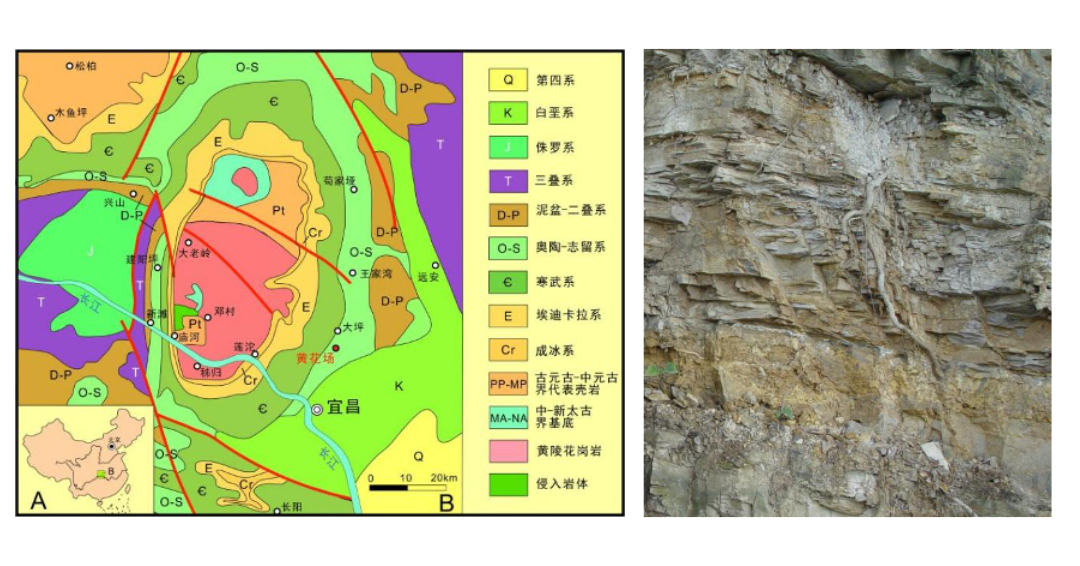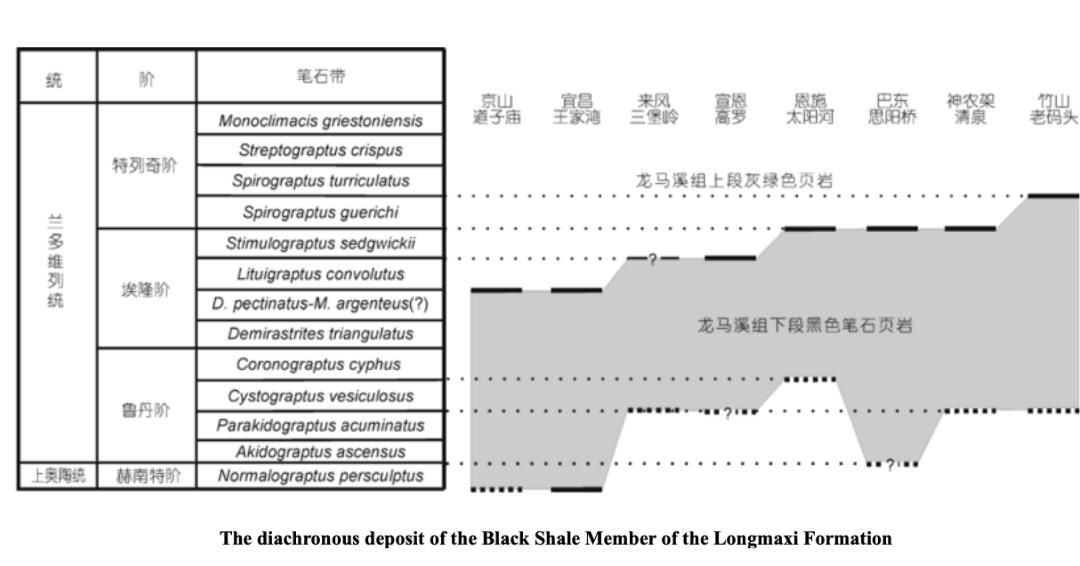Longmaxi Fm
Type Locality and Naming
Yin Zanxun (1943) proposed the Longmaxi Shale. The nominate section is at Longmaxi, 1 km southeast of Xintan in Zigui County, Hubei Province. The type section is at Wangjiawan, Fenxiang, 42 km to the north of the Yichang City, Hubei Province (Fig. 1). Coordinate: 30°58′56″N、111°25′10″E. There are 2 different opinions on the definition of the Longmaxi Formation by different authors, i.e., whether the Longmaxi Formation is including the Black Shale Member and the underlying Wufeng Formation of the Upper Ordovician, and/or the Black Shale Member and the Yellowish-green Shale Member. The first opinion neglects the turnover of the faunas and the change of the climate and environment. And because the changes of the lithology from black shale to gray shale to yellowish green shale is gradual, the top of the formation will be an arbitrary boundary. Consequently, we prefer the second opinion for the Longmaxi Fm to include the Black shale Member and the Yellowish-green Member.
[Figure 1 Upper: Full view of the Wangjiawan Silurian section in Yichang, Hubei Province(photography by Wang G X et al., 2020). Lower: The Longmaxi Formation at the type section in Wangjiawa, Yichang City, Hubei Province]
Synonym: (龙马溪组); Lungmachi Fm; Niuchang Fm (see that entry)
Lithology and Thickness
According to the lithology, the Longmaxi Formation is divided into a lower Black Shale Member (Fig.2 (left)), and an upper Yellowish-green Shale Member (Fig.3 (right)) (Yan and Wang, 1978). The black shale of carbonaceous siltstone or mudstone intercalated with thin chert beds, is getting more silty and more light color upward gradually, totally about 51.9 m thick. The black shale is diachronous both at the base and the top in different regions (Fan et al., 2012) (Fig. 3). Above the black shale, there is the yellowish-green shale, and sandy shale with a few sandstone bands. The thickness is more than 500 m.
[Figure 2. Left: The Longmaxi Formation at the type section in Wangjiawa, Yichang City, Hubei Province. Right: The yellowish green shale of the Longmaxi Formation at the type section in Wangjiawa, Yichang City, Hubei Province]
[Figure 3: The diachronous deposit of the Black Shale Member of the Longmaxi Formation]
Relationships and Distribution
Lower contact
It is conformable with underlying Wufeng Fm in the type section. In the near shore areas, the strata with different graptolite zones at the base of the formation are in unconformable contact with graptolite zones of various horizons of the Wufeng Fm (e.g., in northwest Hunan Province and southwest Hubei Province), of the Lingxiang Fm (e.g., in Shiqian of northeast Guizhou Province) and of the Baota Fm (e.g., in Meitan of northeast Guizhou Province).
Upper contact
The changes of the lithology from black shale to gray shale to yellowish green shale is gradual, the top of the formation will be an arbitrary boundary.
Regional extent
The Longmaxi Formation is widely distributed in middle-upper Yangtze region. The thickness is various from place to place, i.e., about 500 m thick at Yichang, 160-250 m in north Guizhou Province, merely 20-50 m thick in south Shaanxi Province.
GeoJSON
Fossils
Very abundant and diversified graptolite fossils can be found in the black shale and a few graptolite fossils above the black shale. There are 5 graptolite zones, namely, the persculptus Zone, acuminatus Zone, vesiculosus Zone, cyphus Zone and triangulatus Zone in the Black Shale Member, and 2 graptolite zones, the convolutus Zone and possible sedgwickii Zone in the Yellowish-green Shale Member according to Wang (1987) in the type section. According to the recent studies on the drill-core in Yichang area, a gap between the Rhuddanian and the Aeronian was recognized by the graptolite zonation and correlation (Maletz et al., 2019). There is no benthic life in the black shale and only few shelly fossils in the yellowish-green shale.
Age
Depositional setting
The black shale indicates the transgression event on the Yangtze Platform during the earliest Silurian. The restricted basin environment was lasting from the Normalograptus persculptus zone of the Hirnantian of the Late Ordovician to the Early Aeronian, even to early Telychian in different areas. The yellowish-green shale demonstrates a regression upward and the facies is changed from outer shelf to shallow inner shelf.
Additional Information
 Fm outcrop_1.jpg)

 Fm Lithology_1.jpg)
